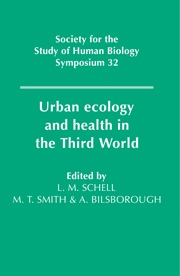Book contents
- Frontmatter
- Contents
- List of contributors
- Acknowledgements
- 1 Human biological approaches to the study of Third World urbanism
- 2 Social and cultural influences in the risk of cardiovascular disease in urban Brazil
- 3 The urban disadvantage in the developing world and the physical and mental growth of children
- 4 Differences in endocrine status associated with urban-rural patterns of growth and maturation in Bundi (Gende-speaking) adolescents of Papua New Guinea
- 5 Nutritionally vulnerable households in the urban slum economy: a case study from Khulna, Bangladesh
- 6 Urban-rural differences in growth and diarrhoeal morbidity of Filipino infants
- 7 Child health and growth in urban South Africa
- 8 From countryside to town in Morocco: ecology, culture and public health
- 9 Urban-rural population research: a town like Alice
- 10 Selection for rural-to-urban migrants in Guatemala
- 11 Health and nutrition in Mixtec Indians: factors influencing the decision to migrate to urban centres
- 12 Urban health and ecology in Bunia, N.E. Zaire, with special reference to the physical development of children
- 13 Food for thought: meeting a basic need for low-income urban residents
- 14 Immunological parameters in northeast Arnhem Land Aborigines: consequences of changing settlement patterns and lifestyles
- 15 Amerindians and the price of modernisation
- 16 Sex ratio determinants in Indian populations: studies at national, state and district levels
- 17 Polarisation and depolarisation in Africa
- 18 Urbanisation in the Third World: health policy implications
- Index
2 - Social and cultural influences in the risk of cardiovascular disease in urban Brazil
Published online by Cambridge University Press: 26 December 2009
- Frontmatter
- Contents
- List of contributors
- Acknowledgements
- 1 Human biological approaches to the study of Third World urbanism
- 2 Social and cultural influences in the risk of cardiovascular disease in urban Brazil
- 3 The urban disadvantage in the developing world and the physical and mental growth of children
- 4 Differences in endocrine status associated with urban-rural patterns of growth and maturation in Bundi (Gende-speaking) adolescents of Papua New Guinea
- 5 Nutritionally vulnerable households in the urban slum economy: a case study from Khulna, Bangladesh
- 6 Urban-rural differences in growth and diarrhoeal morbidity of Filipino infants
- 7 Child health and growth in urban South Africa
- 8 From countryside to town in Morocco: ecology, culture and public health
- 9 Urban-rural population research: a town like Alice
- 10 Selection for rural-to-urban migrants in Guatemala
- 11 Health and nutrition in Mixtec Indians: factors influencing the decision to migrate to urban centres
- 12 Urban health and ecology in Bunia, N.E. Zaire, with special reference to the physical development of children
- 13 Food for thought: meeting a basic need for low-income urban residents
- 14 Immunological parameters in northeast Arnhem Land Aborigines: consequences of changing settlement patterns and lifestyles
- 15 Amerindians and the price of modernisation
- 16 Sex ratio determinants in Indian populations: studies at national, state and district levels
- 17 Polarisation and depolarisation in Africa
- 18 Urbanisation in the Third World: health policy implications
- Index
Summary
Throughout the twentieth century there has been a marked acceleration of processes of modernisation and urbanisation in developing societies. Cities in the Third World, and especially urban centres of South America, have swollen with an influx of migrants from the countryside. In many cases these migrants have been driven by failing rural economies and natural disasters, but of equal importance is the allure of city life. The urban centre holds out the promise of ‘the good life ’; it offers the possibility of achieving the kind of lifestyle and affluence symbolised in media imported from the industrial centres of Europe and North America.
Concomitantly, developing societies have been progressing through that transformation of patterns of morbidity and mortality known as ‘the epidemiologic transition ’. Rates of infectious and parasitic disease have remained high, but rates of chronic disease, and especially coronary heart disease (CHD), have climbed at an alarming rate. For example, in urban Brazil in 1930, infectious and parasitic diseases accounted for half of all deaths, while CHD accounted for only 12%. By 1980, infectious and parasitic diseases accounted for 12% of all deaths, while CHD accounted for 33% (James et al., 1991).
How are we to account for this transition? Conventional wisdom would argue that as modernisation and urbanisation proceed, life becomes more sedentary and diets become more sodium- and fat-laden, which in turn increases blood pressure and unfavourable lipid profiles, and leads to CHD.
- Type
- Chapter
- Information
- Urban Ecology and Health in the Third World , pp. 10 - 25Publisher: Cambridge University PressPrint publication year: 1993
- 6
- Cited by



